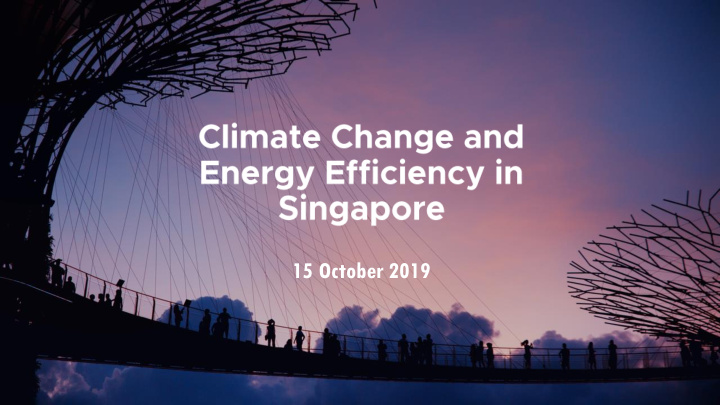



15 October 2019
SINGAPORE’S PLEDGE • Singapore’s GHG emissions totaled To reduce our Emissions Intensity 50.9 MT CO 2 e. The industry sector by 36% from 2005 levels, and forms the bulk of our emissions (~60%). stabilise and peak emissions around 2030. 2
Power Industry Buildings Transport Households Generation 3
• Carbon Pricing Act (CPA) Regulations and Standards • Energy Conservation Act (ECA) • Energy Efficiency National • Energy Efficiency Fund (E2F) Partnership (EENP) • Resource Efficiency Grant for • Singapore Certified Energy Capability Energy (REG(E)) Incentives Manager (SCEM) Programme Development • Investment Allowance (IA-EE) • Energy Services Companies • EE Financing Programme (ESCO) Accreditation • Energy Efficiency Opportunities Assessor (EEOA) Framework 4
Regulations and Standards Capability Incentives Development 5
Regulations and Standards THRESHOLD AND PRICE LEVEL • 25 ktCO 2 e threshold covers around 40 companies that contribute about 80% of total Capability Incentives Development emissions. • Tax applies uniformly to all sectors, without exemption, to provide transparent, fair and consistent carbon price signal across the economy. • Carbon tax rate set at $5/tCO 2 e (~US$4/tCO 2 e) in the first instance, as a transition period for companies to adopt EE projects. • Tax rate to be reviewed by 2023. The intent is to increase the rate to between $10- 15/tCO 2 e by 2030. MECHANISM • Carbon tax is simple to implement, minimises administrative burden on companies. • Fixed-Price Credit-Based (FPCB) mechanism -Puts in place key building blocks (e.g. credit registry infrastructure) to facilitate future use of carbon credits. • Open to explore linking the carbon tax framework to external carbon markets where feasible. 6
Regulations and Standards • Mandating energy management practices under the ECA Capability Incentives Development Appoint energy Monitor & report Submit energy manager energy use & efficiency (SCEM-certified) GHG emissions improvement plan ENERGY-INTENSIVE SECTORS COVERED CONSUMERS 1. Manufacturing & related services 2. Supply of electricity, gas, steam, compressed air & chilled water ≥ 54 TJ/yr 3. Water supply & sewage & waste management Industrial sector 7
Regulations and Standards The EC (Amendment) Act was gazetted on 2 Jun 2017 Capability Incentives Development New facilities & major expansions Existing facilities • Review facility design for EE 1 • Implement structured energy management • Report measured energy data 1 system 2 • Conduct regular EE opportunities assessments (EEOAs) 2 Common industrial equipment & systems • Introduce minimum energy performance standards, starting with motors 1 1 From 2018 onwards 8 2 From 2021/22 onwards
Regulations and Standards EENP Learning Network and Conference • Promotes adoption of in-house energy management systems Capability Incentives • Provides partners with opportunities to learn and share best Development practices and technologies Module-based training for Singapore Certified Energy Managers (SCEM) • Training and certification system in energy management • Training grant to encourage companies to train their employees Energy Services Company (ESCO) Accreditation Scheme • Enhances professionalism and quality of services offered by ESCOs • Enhances confidence in the energy services sector and helps to promote the growth of industry Energy Efficiency Opportunities Assessment (EEOA) Framework • Certify qualified EE professionals with expertise in assessing energy efficiency opportunities of energy-consuming and industrial processes/systems 9
Regulations and Standards NEA’S ENERGY EFFICIENCY FUND (E2F) • E2F provides up to 50% co-funding for the following: Capability Incentives Development Resource efficiency design of new facilities and major expansions Adoption of energy-efficiency technologies Energy assessments of existing facilities EMIS (NEW!) Energy Management Information Systems Help companies in the digitalisation of their energy management systems 10
Regulations and Standards NEA’S ENERGY EFFICIENCY FUND (E2F) ENERGY MANAGEMENT INFORMATION SYSTEMS Up to 50% of Capability Incentives Development EMIS qualifying costs , • Capture/consolidate energy performance- capped at related plant data • Dashboards for visualization and monitoring i) $250K per energy- • Reporting and analysis tools to spur intensive facility (i.e. identification of performance gaps and consuming ≥ 54 TJ opportunities of energy annually) and; Qualifying Costs Equipment and Materials Include instruments, data transmission and storage i) $125K per facility systems, other related hardware and systems for other facilities. Professional services Include engineering and design, programming, guidance on use, training, commissioning support Software and IT services: Include software licensing, cloud-based services 11
Regulations and Standards EDB’S ENERGY EFFICIENCY SCHEMES AND INCENTIVES Resource Efficiency Grant for Energy ((REG(E)) Capability Incentives Development • Supports EE improvement and removal of non-CO 2 GHG projects • Grant support will correspond to the amount of carbon abatement achieved, with minimum carbon abatement of 0.5 ktpa Investment Allowance for Energy Efficiency (IA-EE) • Supports EE improvement projects • Provides capital allowance of 30% of more of approved fixed capital expenditure, on top of normal capital allowance EE Financing Programme • Provides 3 rd party financing for upfront costs of EE improvement projects • Investment return can typically be ‘paid from savings’, based on a share of energy savings for an agreed contractual term 12
Q&A 13
Recommend
More recommend